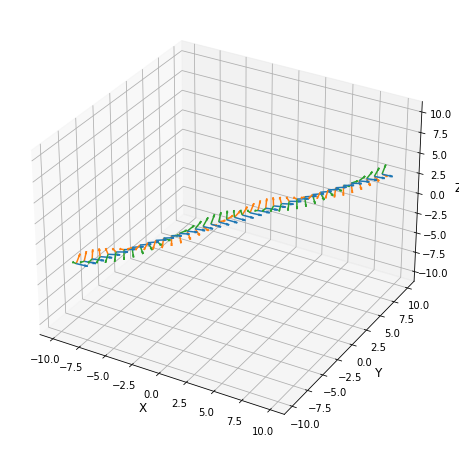Notebook source code:
notebooks/04_practical_methods__from_vector_spaces_to_manifolds.ipynb
Run it yourself on binder
From vector spaces to manifolds#
Lead author: Nina Miolane.
We import the backend that will be used for geomstats computations and set a seed for reproducibility of the results.
In [1]:
import geomstats.backend as gs
gs.random.seed(2020)
INFO: Using numpy backend
Finally, we import the visualization module.
In [2]:
import matplotlib.pyplot as plt
import geomstats.visualization as visualization
visualization.tutorial_matplotlib()
From vector spaces to manifolds#
In the previous tutorial, we visualized data that naturally belong to manifolds, i.e. generalizations of vector spaces that are allowed to have curvature.
A simple example of such data is the coordinates of cities on the surface of the earth: they belong to a sphere, which is a manifold.
In [3]:
import geomstats.datasets.utils as data_utils
data, names = data_utils.load_cities()
fig = plt.figure(figsize=(10, 10))
ax = fig.add_subplot(111, projection="3d")
visualization.plot(data[15:20], ax=ax, space="S2", label=names[15:20], s=80, alpha=0.5)
ax.set_title("Cities on the earth.");
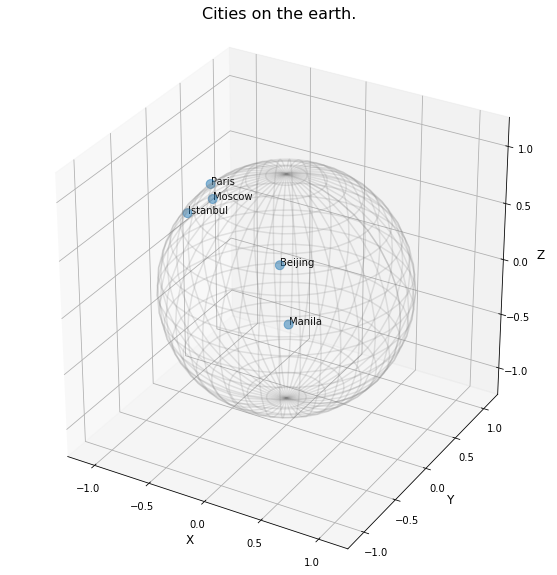
The purpose of this tutorial is to show how we can perform elementary computations on such data.
From addition to exponential map#
The elementary operations on a vector space are: addition, substraction and multiplication by a scalar. We can add a vector to a point, substract two points to get a vector, or multiply a vector by a scalar value.
In [4]:
%matplotlib inline
fig = plt.figure(figsize=(6, 6))
ax = fig.add_subplot(111)
point_a = gs.array([0, 1])
point_b = gs.array([1, 2])
vector = point_b - point_a
ax.scatter(point_a, point_b, label="Points")
ax.arrow(
gs.to_numpy(point_a[0]),
gs.to_numpy(point_a[1]),
dx=gs.to_numpy(vector[0]),
dy=gs.to_numpy(vector[1]),
width=0.008,
length_includes_head=True,
color="black",
)
ax.legend();
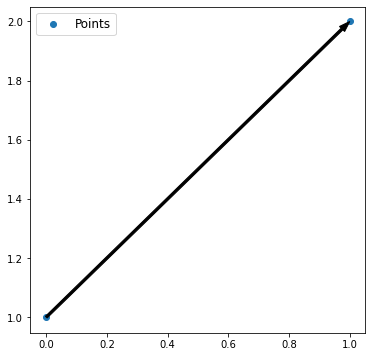
For points on a manifold, like the sphere, the same operations are not permitted. Indeed, adding a vector to a point will not give a point that belongs to the manifold.
In [5]:
fig = plt.figure(figsize=(10, 10))
ax = fig.add_subplot(111, projection="3d")
paris = data[19]
vector = gs.array([1, 0, 0.8])
ax = visualization.plot(paris, ax=ax, space="S2", s=200, alpha=0.8, label="Paris")
arrow = visualization.Arrow3D(paris, vector=vector)
arrow.draw(ax, color="black")
ax.legend();
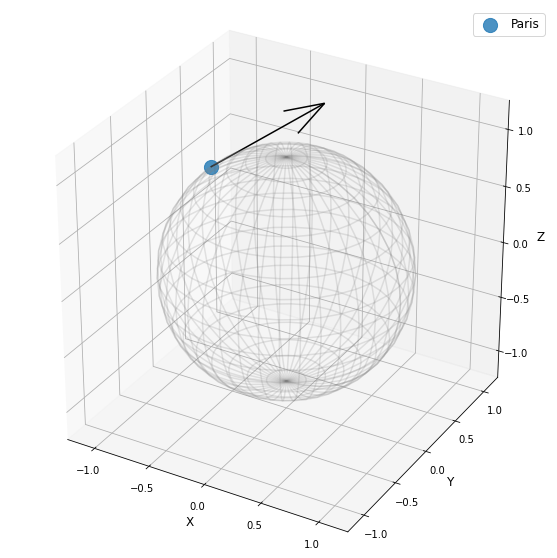
The exponential map is the operation that generalizes the addition of a vector to a point, on manifolds.
The exponential map takes a point and a tangent vector as inputs, and outputs the point on the manifold that is reached by “shooting” with the tangent vector. “Shooting” means taking the path of shortest length. This path is called a “geodesic”.
In [6]:
from geomstats.geometry.hypersphere import Hypersphere
sphere = Hypersphere(dim=2)
paris = data[19]
vector = gs.array([1, 0, 0.8])
tangent_vector = sphere.to_tangent(vector, base_point=paris)
result = sphere.metric.exp(tangent_vector, base_point=paris)
geodesic = sphere.metric.geodesic(
initial_point=paris, initial_tangent_vec=tangent_vector
)
points_on_geodesic = geodesic(gs.linspace(0.0, 1.0, 30))
In [7]:
fig = plt.figure(figsize=(10, 10))
ax = fig.add_subplot(111, projection="3d")
ax = visualization.plot(paris, ax=ax, space="S2", s=100, alpha=0.8, label="Paris")
ax = visualization.plot(result, ax=ax, space="S2", s=100, alpha=0.8, label="End point")
ax = visualization.plot(
points_on_geodesic, ax=ax, space="S2", color="black", label="Geodesic"
)
arrow = visualization.Arrow3D(paris, vector=tangent_vector)
arrow.draw(ax, color="black")
ax.legend();
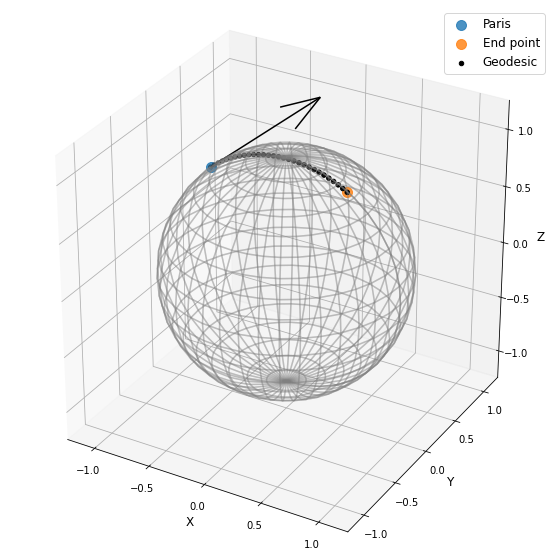
From substraction to logarithm map#
The logarithm map is the operation that generalizes the substraction of two points, that gives a vector.
The logarithm map takes two points on the manifold as inputs, and outputs the tangent vector that is required to “shoot” from one point to the other.
In [8]:
paris = data[19]
beijing = data[15]
log = sphere.metric.log(point=beijing, base_point=paris)
geodesic_func = sphere.metric.geodesic(initial_point=paris, end_point=beijing)
points_on_geodesic = geodesic_func(gs.linspace(0.0, 1.0, 30))
In [9]:
fig = plt.figure(figsize=(10, 10))
ax = fig.add_subplot(111, projection="3d")
ax = visualization.plot(paris, ax=ax, space="S2", s=100, alpha=0.8, label="Paris")
ax = visualization.plot(beijing, ax=ax, space="S2", s=100, alpha=0.8, label="Beijing")
ax = visualization.plot(
points_on_geodesic, ax=ax, space="S2", color="black", label="Geodesic"
)
arrow = visualization.Arrow3D(paris, vector=log)
arrow.draw(ax, color="black")
ax.legend();
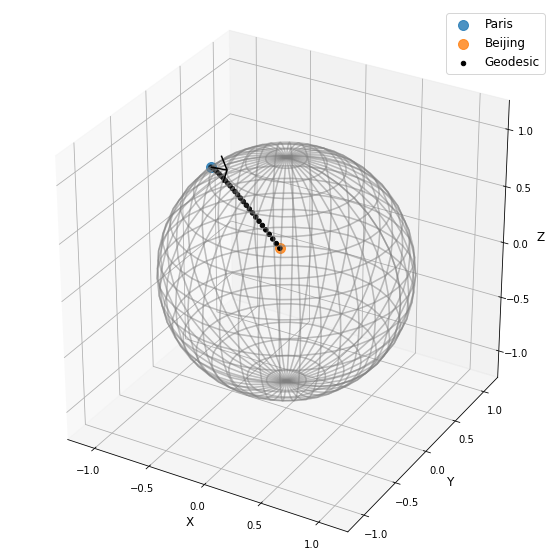
Geodesics#
So far, we have given examples of geodesics on the sphere. The sphere is a simple manifold that is easy to visualize. Yet, geomstats provides many more manifolds, on which the exp and log are defined. Let’s present a few more.
Geodesics on the hyperbolic plane#
We consider the hyperbolic geometry here. We define two points on the hyperbolic plane and compute the geodesic between them.
In [10]:
from geomstats.geometry.hyperboloid import Hyperboloid
hyperbolic = Hyperboloid(dim=2)
initial_point = gs.array([gs.sqrt(2.0), 1.0, 0.0])
end_point = gs.array([2.5, 2.5])
end_point = hyperbolic.from_coordinates(end_point, "intrinsic")
geodesic_func = hyperbolic.metric.geodesic(
initial_point=initial_point, end_point=end_point
)
points = geodesic_func(gs.linspace(0.0, 1.0, 10))
We use the visualization module to plot the two points and the geodesic between them. We can choose the visualization we prefer for points on the hyperbolic plane. First we visualize with the Poincare disk representation.
In [11]:
fig = plt.figure(figsize=(8, 8))
ax = fig.add_subplot(111)
representation = "H2_poincare_disk"
ax = visualization.plot(
initial_point, ax=ax, space=representation, s=50, label="Initial point"
)
ax = visualization.plot(end_point, ax=ax, space=representation, s=50, label="End point")
ax = visualization.plot(
points[1:-1], ax=ax, space=representation, s=5, color="black", label="Geodesic"
)
ax.set_title("Geodesic on the hyperbolic plane in Poincare disk representation")
ax.legend();
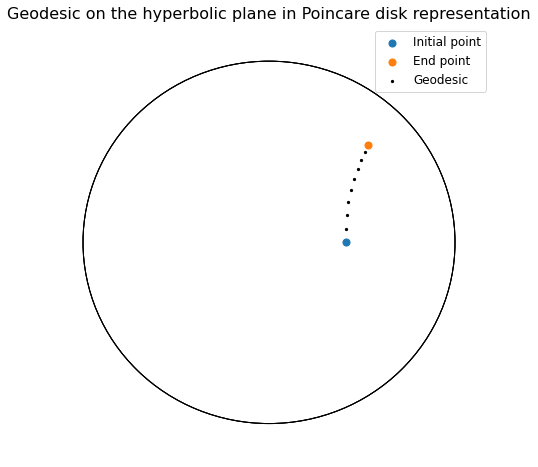
We can visualize the same geodesic in Klein disk representation.
In [12]:
fig = plt.figure(figsize=(8, 8))
ax = fig.add_subplot(111)
representation = "H2_klein_disk"
ax = visualization.plot(
initial_point, ax=ax, space=representation, s=50, label="Initial point"
)
ax = visualization.plot(end_point, ax=ax, space=representation, s=50, label="End point")
ax = visualization.plot(
points[1:-1], ax=ax, space=representation, s=5, color="black", label="Geodesic"
)
ax.set_title("Geodesic on the hyperbolic plane in Klein disk representation")
ax.legend();
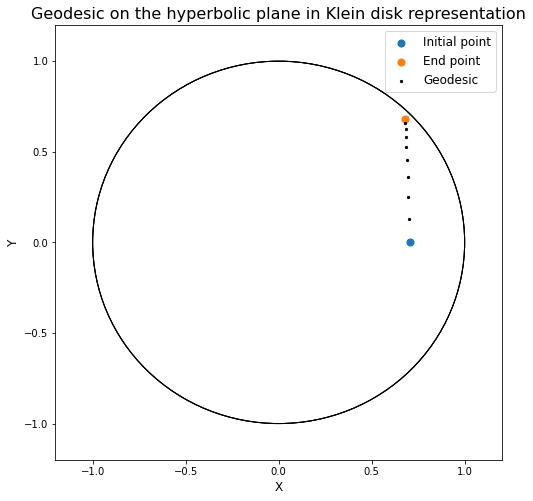
Geodesics on the special euclidean group SE(3)#
We consider the special euclidean group in 3D, which is the group of 3D rotations and 3D translations. One element of this group can be represented by a frame, oriented by the 3D rotation, and located by the 3D translation from the origin.
We create two points in SE(3), and compute the geodesic between them.
In [13]:
from geomstats.geometry.special_euclidean import SpecialEuclidean
se3 = SpecialEuclidean(n=3, point_type="vector")
initial_point = se3.identity
initial_tangent_vec = gs.array([1.8, 0.2, 0.3, 3.0, 3.0, 1.0])
geodesic = se3.metric.geodesic(
initial_point=initial_point, initial_tangent_vec=initial_tangent_vec
)
points = geodesic(gs.linspace(-3.0, 3.0, 40))
We visualize the geodesic in the group SE(3), which is a path of frames in 3D.
In [14]:
fig = plt.figure(figsize=(8, 8))
ax = fig.add_subplot(111, projection="3d")
visualization.plot(points, ax=ax, space="SE3_GROUP");
